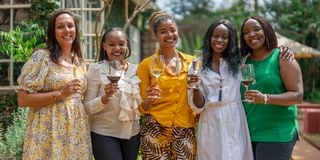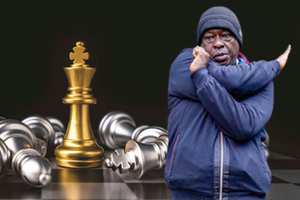Meet the women who’ll represent Kenya in Wine Olympics

From left: Members of Team Wine Kenya Soraiya Ladak, Beverly Mbaika, Melissa Mwende, Joy Adero, and Victoria Mulu-Munywoki. They will be competing in the Wine Olympics in France.
What you need to know:
- The event will bring together more than 30 countries from around the world to showcase and test their skills.
- The drink to be used in the blind tasting competition can originate from any wine-making country in the world.
From religious texts to ancient human history, wine has featured as one of the first alcoholic beverages to ever be invented and has stood the test of time as a drink for all occasions. No wonder it has earned the right to get its own spin-off of the ‘Olympics’—and this time Kenya is determined to get a taste of the action.
For the first time, five Kenyan women — Joy Adero, Melissa Mwende, Soraiya Ladak, Beverly Mbaika and Victoria Mulu-Munywoki — are expected to represent Kenya in the Olympics of Wine also known as the World Blind Tasting Championship on October 7 and 8 in Champagne Ayala, France.
The five sommeliers (professionals with knowledge about the drink) collectively have a vast understanding and expertise in the art of wine tasting and share a deep passion for its culture.
The World Blind Tasting Championship, organised by La Revue du Vin de France, was born following the European Wine tasting championship in 2013. The event will bring together more than 30 countries from around the world to showcase their skills.
“It is the ultimate test of taste and smell. Twelve glasses will be lined up before each of us, half of them with red wine of different kinds and the other half with white wines,” said Beverly holding a 2013 Vergelegen V Red Wine bottle imported from South Africa and priced at an average of Sh13,000 per bottle. The price for most good wines ranges between Sh3,000 and Sh200,000 depending on how it was made or the age, among other factors.
Five aspects of wine
The test for the contestants is to identify five aspects of the wine: the type of grape used to make it, which country it is from, the region in the country it originates from, the producer of the wine and the year it was made. The drink to be used in the blind tasting competition can originate from any wine-making country in the world.
“Joseph Dhafana, a world-renowned winemaker and sommelier from Zimbabwe, recognised the promise in the Kenyan sommeliers and inspired us to join the coveted competition during his recent visit to Nairobi,” says Melissa, who has more than nine years of experience in wine tasting and holds a degree in Food Science.
Kenya, Zimbabwe and South Africa are the only African countries participating in the competition. However, the Kenyan team is still appealing for support from sponsors to ensure their participation.
When Lifestyle visited the team during one of their training sessions at De Vries Africa Ventures, the presence of wine professionals was evident with references such as “Sauvingon Blanc” and “Bordeaux” being thrown around the room as they tried to identify the types of grapes they were tasting in their glasses.
“The challenging bit is that one type of grape such as Cabernet Sauvignon that is grown in France, South Africa and Australia tastes different because of the climate conditions of that area. There are also differences when it is handpicked or by machines. Such a skill is grown over a long time and exposure to different brands all over the world,” says Joy, who is also a restaurant owner and a wine connoisseur.
She demystifies why the different wines come in different colours.
“It is the skin of the grape. Red wine gets its colours from fermentation done together with the red grape skins. White wine is made out of grapes that are skinned. Meanwhile, Rosé is a lighter version of red wine where the skins are fermented with the wine for a shorter period than in red winemaking.”
And, as Lifestyle found out, there are a lot of interesting facts and figures about wines. Joy, for example, explains that if a wine bottle is labelled a year such as 2017, it refers to when the grapes used to make it were harvested. If it is opened this year, one can say that they are drinking a five-year bottle. However, she singles out a type called non-vintage wines that are made by blending grapes from different years of the harvest to create a nice depth and complexity. Bottles with specific years labelled are known as vintage wines.
Age of wine
Soraiya picks up a red wine glass to demonstrate the technique they use to tell the age of wine. She tilts the glass with red wine on a white surface to show the rims formed. “If the wine gets lighter towards the edges then that means it is an older wine.”
Soraiya, who has gained knowledge over the years through a family business in Nairobi known as the Wine Shop, says: “Certain wines, no matter where they come from, would have signature traits. Wine tasting invokes many different emotions. That is why I think women are pretty good at wine tastings because they can identify the different elements and take out the bias. We can identify flavours through memories by associating them with a place or time you have ever tasted it.”
She explains that one needs a clean palate to taste a different wine. “When we are switching from one wine to another, we use palate cleansers that each serve their purpose. We prefer crackers which have no taste and a very little salt and slices of green apples, which introduce acidity to the palate leaving a fresh feeling,” she says.
All the women have gone through the Wine and Spirit Education Trust programme, a four-level international qualification for wine professionals and enthusiasts. Through the programme they have learnt how to identify the main types and styles of wine through sight, smell, and taste, while also gaining the basic skills to describe wines accurately.
They are also equipped with knowledge of the principal and regionally important grape varieties of the world, the regions in which they are grown, and the styles of wine they produce. The programme has helped them to develop a detailed understanding of grape growing and winemaking how and why wine production and business factors influence the style, quality, and price of wines.
The work of a sommelier is to create and update wine lists, make recommendations on food and wine pairings, and advise guests on wines based on their personal tastes.
“Sometimes finding the perfect wine for a guest might be a challenge, especially for those who are also wine enthusiasts themselves. However, the perks of the job are that you would have the pleasure of meeting very important people,” says Beverly, whose list of VIPs includes a Cabinet Secretary and his family.
While the team are pioneers, they hope to start a tradition of representation of Team Wine Kenya on the world stage. They believe that participation in this competition will undoubtedly put Kenya in a different league in the world of wine.
“It will be a testament to the fact that the wine industry in Kenya is taking firm root and growing, not only in terms of purchase but also in the discernment and appreciation of good wine as an aspirational lifestyle,” says Victoria who is the team captain and has been in the industry for more than 20 years.
Melissa tells Lifestyle that she and her teammates sometimes suffer from alcohol fatigue, which is one of the downsides of preparing for this competition.
“Even when you do not want to drink, you have to because we must practise getting flavours right. I now cannot sleep more than three hours each night. We usually sip and spit to avoid getting drunk but we still eventually ingest some of the wine. We usually taste about 12 different wines during every training session,” says Melissa.
Victoria points out that even some of the best sommeliers do not even drink wine and can tell the qualities of the wine by only smelling it
“My family and friends think that I am living the best life, drinking wine at 9 in the morning but there is so much knowledge, skill and attention to detail that goes into being the best at wine tasting,” says Soraiya.
Wine etiquette
Kenya’s appetite and interest for wine has grown over the years with a growing number of enthusiasts. However, there are a few mistakes even wine lovers make as they indulge themselves. The team captain, Victoria, points out that it starts from how a corked bottle of wine is opened.
“When you are using a corkscrew, drive it in until the second rank. We use a little Physics here. You have to think about the fulcrum and pivoting to evenly distribute the energy to pop it out of the bottle. If you push the corkscrew down to the last rank, the cork is going to split when you try to pull it out. This will leave pieces of the cork in the wine dirtifying it,” she says as she demonstrated.
An opened corked wine bottle can only last two days after it is re-corked, she says. “Wine gets spoilt when it comes into contact with oxygen. Some companies have devised ways of using other gases heavier than oxygen such as argon to displace it and create a protective layer over the drink. This can preserve it for a week or more.”
She adds that if you cannot drink your wine straight away once opened, you can cook with it as long as it is not spoiled.
Wine glasses come in different shapes and sizes as each serves its own purpose.
"The shape of the glass affects the taste of the wine," says Melissa.
Victoria shows how the throw of each glass lands on a specific part of the tongue that it was designed to target.
“The narrower the rim, the more precise the throw is. When you look at a red wine glass, the bowl is more open and the rim is wider because red wine contains tannins, acidity and flavours. The design of the glass allows it to open up before you sip it. Unlike white wine and bubbly drinks, the throw of red wine needs to land on the whole tongue to pick up savoury and sweet notes,” she explains.
The flute, for instance, is used for bubbly drinks such as champagne and prosecco to preserve the bubbles. Champagne, Britannica.com explains, would just be another white wine without those tiny bubbles. As the bubbles ascend the length of a glass in tiny trails, they drag along molecules of flavour and aroma, which explode out of the surface, tickling the nose and stimulating the senses.
“Flute glasses are narrower in design than other wine glasses to retain the champagne’s signature carbonation that causes the bubbles by reducing the surface area for it to escape,” Victoria says.
She reveals that red wine glasses have a bigger bowl than the rest to allow more air to interact with the wine, which allows the flavours to open up and display more prominently.
“Glasses should be handled by the stem and not the bowl because the palm is one of the warmest parts of your hand. The heat then increases the temperature of the wine, which might compromise the taste of your wine,” she says.
She also cautions from touching the rim of the glass, which may leave body scents and perfumes on the glass. That would confuse the smell and taste buds.
“Remember to only use the flat base of the glass to move your glass around on a table.”
The team is expected to carry a bottle of wine made in their country. “We will be carrying Leleshwa. There are very few wineries in Kenya because the country lies on the equator hence conditions are not favourable to plant and farm grapes used to make wine. The grapes we buy from the shop are not the same ones used for wine,” Victoria says.
Fans and corporates can show support or sponsor Team Wine Kenya ahead of the event and follow their journey on Instagram and Tiktok through their social media page, @teamwinekenya.





